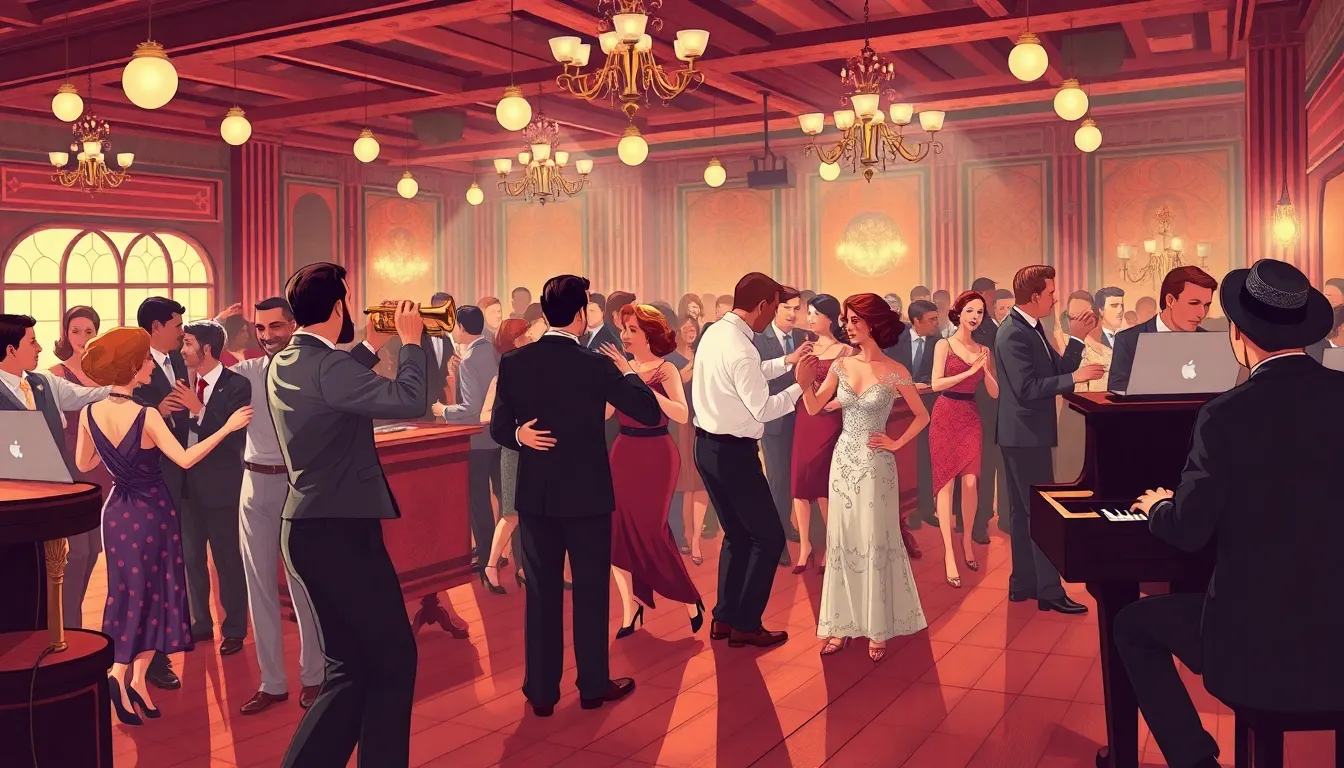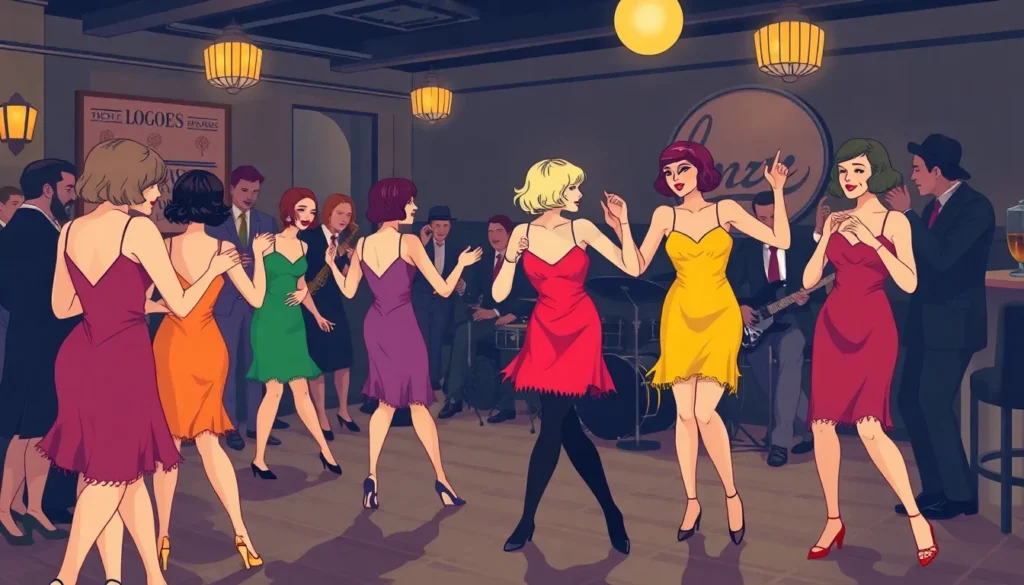The 1920s was a decade that roared louder than a jazz band on a Saturday night. Picture flappers dancing the Charleston while speakeasies buzzed with the thrill of prohibition. This era wasn’t just about the glitz and glam; it was a cultural revolution that transformed how people sought joy and escapism.
1920s Entertainment
The 1920s saw a dynamic shift in entertainment reflecting societal changes. Jazz music surged in popularity, with artists like Louis Armstrong and Duke Ellington captivating audiences. Dance halls filled with people eager to partake in the Charleston, which became a defining dance of the era.
Film also transformed during this decade, moving towards sound and color. In 1927, “The Jazz Singer” premiered as the first talking picture, revolutionizing cinema. Movie theaters became central to social life, showcasing the glamorous lives of stars like Mary Pickford and Charlie Chaplin.
Literature thrived with writers like F. Scott Fitzgerald and Ernest Hemingway shaping modern American fiction. Their works delved into themes of disillusionment and the pursuit of happiness, resonating with a generation eager for change.
The advent of radio played a crucial role in entertainment as well. Families gathered around the radio to listen to broadcasts featuring music, news, and serialized stories. This medium connected communities and provided a new form of escapism.
The rise of recreational activities also influenced entertainment choices. Sports gained popularity, with figures like Babe Ruth attracting large crowds at baseball games. Spectators found excitement in athletic events, contributing to a vibrant sporting culture.
The 1920s embodied a spirit of liberation and creative expression, making it a significant period in entertainment history. This decade left a lasting impact on future generations, forever altering the landscape of music, film, literature, and sports.
Popular Music of the 1920s

The 1920s was a pivotal decade for music, showcasing the emergence of new genres and influential artists. Jazz music epitomized this era’s cultural transformation.
Jazz and Its Rise
Jazz captured the spirit of the Roaring Twenties. Pioneers like Louis Armstrong and Duke Ellington brought innovation to the genre, blending African American musical traditions with blues and ragtime. Audiences flocked to dance halls, eager to experience lively performances. Syncopated rhythms and improvisation defined jazz, encouraging expressive dance styles like the Charleston. The genre’s popularity extended beyond borders, influencing musicians globally and shaping future music trends.
The Influence of Radio
Radio revolutionized the music landscape during the 1920s. As homes acquired radios, audiences gained instant access to live performances and broadcasts. The medium bridged geographic gaps, connecting listeners to artists like Bing Crosby and the aforementioned jazz greats. Broadcasting networks emerged, promoting new music and genres. As a result, regional styles gained national attention, fostering a shared musical identity across the country. Radio established itself as a crucial platform that contributed to the widespread appreciation of 1920s music.
Cinema in the 1920s
The 1920s marked a pivotal era in cinema, showcasing a remarkable evolution in film that mirrored the cultural dynamism of the time.
Silent Films and Their Stars
Silent films dominated the early part of the decade, captivating audiences with visual storytelling. Iconic figures such as Charlie Chaplin and Buster Keaton became household names, with their comedic genius appealing to millions. Chaplin’s “The Kid” highlighted emotional depth while Keaton’s “The General” demonstrated innovative stunts and timing. The allure of silent cinema lay in its ability to convey universal themes without dialogue, allowing international audiences to engage with the narratives effortlessly. The energy of this era set the stage for transformative changes in the film industry.
The Advent of Talkies
The introduction of sound marked a revolutionary shift in cinema, capturing viewers’ imaginations in unprecedented ways. “The Jazz Singer,” released in 1927, became the first successful talking picture, featuring synchronized sound and music. This innovation changed how stories were told, merging audio with visual elements to enhance emotional connection. Film stars like Al Jolson emerged, blending musical talent with acting skills, attracting diverse audiences. The transition to talkies also prompted theaters to invest in new technology, ensuring a rich auditory experience. As a result, the film industry evolved rapidly, fundamentally altering the entertainment landscape.
Theater and Live Performances
The 1920s showcased a rich tapestry of theater and live performances, reflecting societal changes and the vibrant culture of the era.
Broadway’s Golden Age
Broadway emerged as a focal point of American theater during the 1920s. This period marked the advent of lavish musicals and iconic productions that captivated audiences. Notable shows like “Show Boat” combined compelling storytelling with unforgettable music, setting a new standard for theatrical works. Performers such as Ethel Waters and Al Jolson became household names, drawing large crowds to the famed theaters of New York City. The dazzling lights of Broadway symbolized the spirit of the decade, making it a hub of creativity and entertainment.
Vaudeville Shows
Vaudeville shows thrived during the 1920s, offering a variety of entertainment that appealed to diverse audiences. These performances featured comedians, musicians, dancers, and magicians, providing something for everyone. Venues hosted acts that ranged from solo performers to multi-act extravaganzas, ensuring a mix of humor and talent. Vaudeville strengthened community ties as families flocked to theaters for a night of laughter and enjoyment. Notable performers like W.C. Fields and the Marx Brothers garnered immense popularity, solidifying the legacy of vaudeville in American entertainment history.
Fashion and Social Changes in Entertainment
Fashion during the 1920s illustrated the era’s social changes in entertainment. Flappers donned short dresses, bobbed hair, and bold accessories, challenging traditional norms. This shift allowed women to express newfound freedoms and independence through their attire. Jazz clubs and dance halls became popular venues where these fashion statements flourished. Clothing styles mirrored the upbeat nature of jazz music, fostering connections between style and the vibrancy of the era.
Social changes also influenced entertainment dynamics. The rise of speakeasies reflected a rejection of Prohibition, showing the desire for escapism. Such venues provided a space where people from diverse backgrounds mingled freely, solidifying a sense of community. With music pulsating, audiences embraced the rhythms of jazz while flaunting the latest fashions.
Silent films transitioned to talkies, significantly impacting the film industry’s fashion. Stars became icons, setting trends that audiences eagerly followed. The influence of figures like Clara Bow showcased the glamour that came to define Hollywood. This shift in cinema not only changed entertainment but affected personal style across the nation.
The growth of radio further democratized access to entertainment, promoting new fashion trends. Programs featured popular music and performers, inspiring listeners to adopt styles seen on their favorite stars. The synergy between entertainment and fashion established a cultural identity that resonated beyond the decade.
Additionally, theater showcased lavish productions that highlighted the era’s social changes. Broadway musicals often included glamorous costumes, capturing the imagination of theatergoers. Performers such as Ethel Waters embodied this blend of fashion and performance, making lasting impressions. Overall, the 1920s marked a significant cultural evolution, where fashion and entertainment complemented each other in exciting new ways.
Conclusion
The 1920s stand out as a pivotal decade that reshaped the landscape of entertainment. With jazz music captivating hearts and the film industry embracing sound, this era sparked a cultural renaissance. The vibrancy of dance halls and the allure of Broadway reflected the societal shifts of the time.
Fashion played an equally important role, as flappers and trendsetters challenged conventions and expressed newfound freedoms. The emergence of radio connected communities and democratized access to entertainment, fostering a shared cultural identity.
Ultimately, the 1920s not only revolutionized entertainment but also laid the groundwork for future artistic expression, leaving an indelible mark on American culture.



